Table of Contents
If you’re a proud owner of a Golden Retriever puppy, you’re in for a treat. These adorable and friendly dogs are eager to please and make fantastic companions. However, to ensure that your Golden Retriever puppy grows up to be a well-behaved and obedient dog, you need to invest some time and effort into training them properly.
Training a Golden Retriever puppy can seem daunting, but it doesn’t have to be. With the right tools, techniques, and a bit of patience, you can train your puppy to be a well-behaved and obedient dog. In this article, we’ll cover everything you need to know about how to train a Golden Retriever puppy, from understanding your puppy’s behavior to advanced training skills and techniques. So, let’s get started!
How to Train a Golden Retriever Puppy?
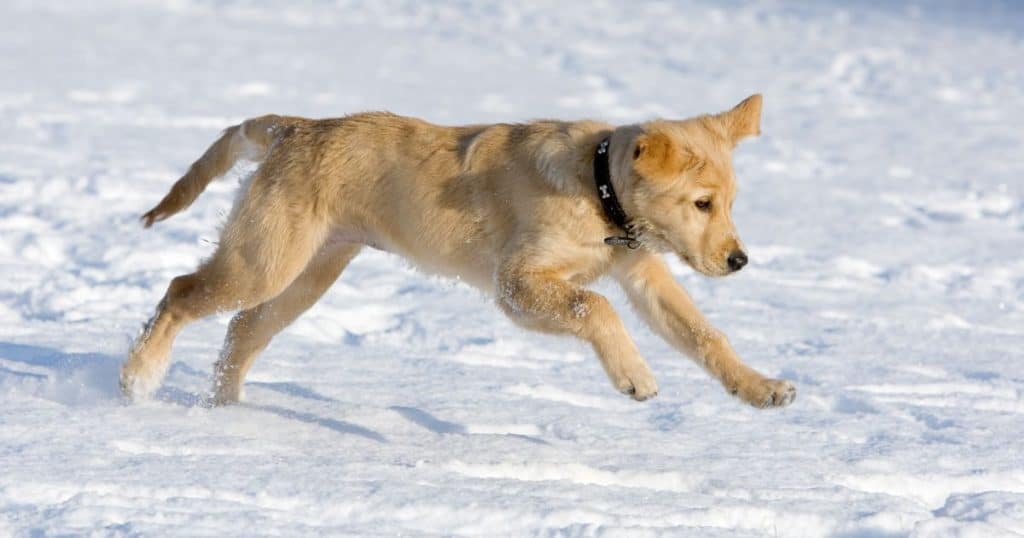
- Understanding your Golden Retriever puppy’s behavior is crucial to effective training.
- Positive reinforcement and rewards are essential for successful training.
- Consistency and patience are key to training a Golden Retriever puppy.
Understanding Your Golden Retriever Puppy
If you’re a new Golden Retriever puppy owner, congratulations! You’ve just welcomed a furry friend into your home who will bring you years of joy and companionship. Golden Retrievers are known for their friendly and loyal personalities, making them a popular breed for families and individuals alike.
As you begin your journey with your new Golden Retriever puppy, it’s important to understand the breed’s unique characteristics. Golden Retrievers are known for being intelligent, eager to please, and highly trainable. This makes them great candidates for obedience training and other forms of structured learning.
However, it’s also important to understand that Golden Retriever puppies can be quite energetic and playful. They require plenty of exercise and playtime to keep them happy and healthy. As a new Golden Retriever puppy owner, it’s important to make sure that you have enough time and energy to devote to your new furry friend.
Golden Retriever puppies also require socialization to help them become well-adjusted adult dogs. This means exposing them to a variety of people, animals, and environments in a positive and controlled manner. Puppy Kindergarten and other group-based training classes can be a great way to provide this socialization while also teaching your puppy basic obedience skills.
In summary, Golden Retriever puppies are intelligent, eager to please, and highly trainable. They require plenty of exercise, socialization, and structured learning to become well-adjusted adult dogs. As a new Golden Retriever puppy owner, it’s important to understand these characteristics and to provide your puppy with the time, attention, and training they need to thrive.
Essential Training Equipment
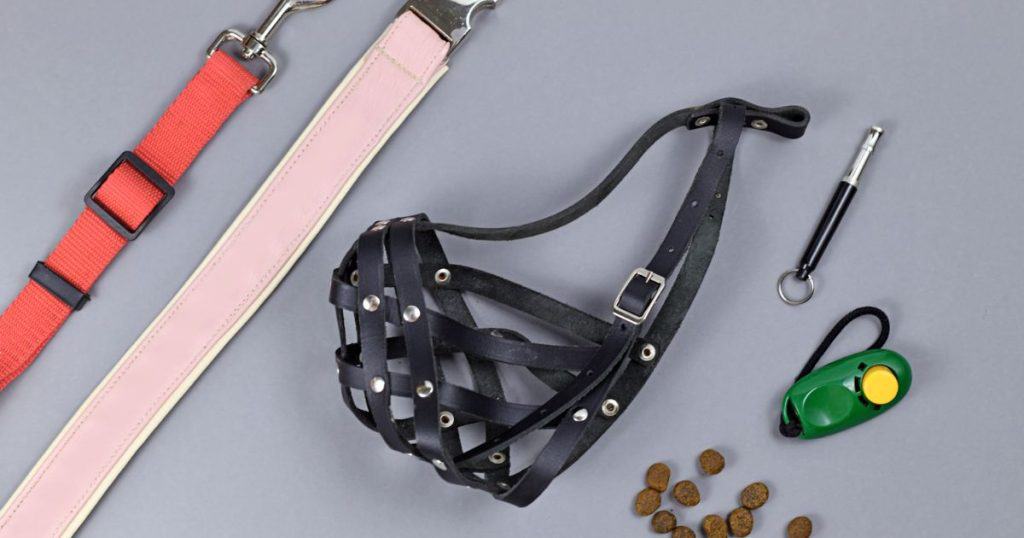
To train your Golden Retriever puppy effectively, you will need some essential training equipment. These tools will help you teach your puppy basic obedience, socialization, and other skills. Here are some of the most important pieces of equipment you will need:
Leash and Collar
A leash and collar are essential for controlling your puppy during walks and training sessions. A good leash should be sturdy, comfortable, and easy to grip. A collar should be adjustable, durable, and fit your puppy’s neck snugly without being too tight.
Crate
A crate is a great tool for housebreaking your puppy and keeping the dog safe and secure when you’re not around. A good crate should be spacious enough for your puppy to stand up, turn around, and lie down comfortably. It should also be durable, easy to clean, and well-ventilated.
Toys
Toys are essential for keeping your puppy entertained and engaged during training sessions. Golden Retrievers are known for their love of play, so make sure to choose toys that are durable, safe, and stimulating. Toys that can be stuffed with treats are especially useful for keeping your puppy focused and motivated.
Treat Pouch
A treat pouch is a handy tool for keeping treats close at hand during training sessions. A good treat pouch should be durable, easy to clean, and large enough to hold a variety of treats. It should also be easy to access, so you can quickly reward your puppy for good behavior.
Harness
A harness is a great alternative to a collar for controlling your puppy during walks and training sessions. A good harness should be adjustable, comfortable, and allow your puppy to move freely. It should also be easy to put on and take off, so you can quickly get your puppy ready for training.
Playpen
A playpen is a great tool for keeping your puppy contained and safe during training sessions. A good playpen should be sturdy, easy to set up, and large enough for your puppy to move around comfortably. It should also be easy to clean, so you can quickly tidy up after training sessions.
By using these essential training equipment, you can ensure that your Golden Retriever puppy gets the best training experience possible. Remember to choose high-quality equipment that is safe, durable, and comfortable for your puppy.
Setting Up a Training Routine
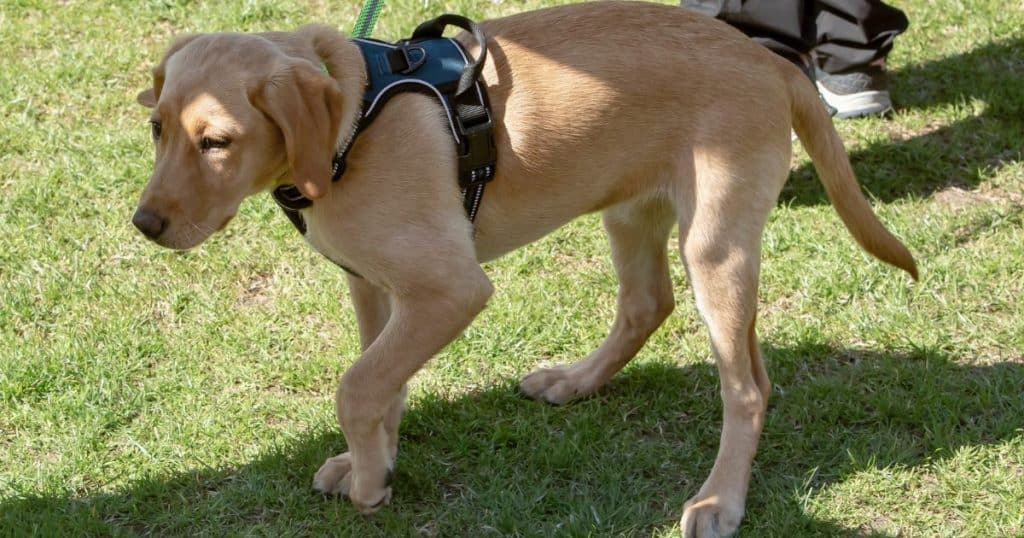
To train your Golden Retriever puppy successfully, you need to establish a routine. A routine is essential for creating consistency, which is vital in training your puppy. Consistency is key to ensuring that your puppy learns and retains what they are being taught.
When setting up a training routine, you need to create a schedule that works for both you and your puppy. You should plan to train your puppy at the same time every day, so they know what to expect and can prepare mentally and physically.
You should also ensure that you have everything you need for training, such as treats, toys, and a leash. Having everything you need within reach will help you to stay focused on the training, and it will make the process smoother.
During the training, you should use positive reinforcement to encourage your puppy to behave appropriately. Positive reinforcement can be anything from treats and toys to verbal praise and physical affection. By using positive reinforcement, you will help your puppy to associate good behavior with positive outcomes.
It is also essential to keep your training sessions short and sweet. Puppies have a short attention span, so you should aim to train for no more than 15 minutes at a time. This will help your puppy to stay focused and engaged, and it will prevent them from becoming bored or frustrated.
In conclusion, setting up a training routine is essential for successfully training your Golden Retriever puppy. By creating a schedule, having everything you need, using positive reinforcement, and keeping your training sessions short, you will help your puppy to learn and retain what they are being taught.
Basic Obedience Training
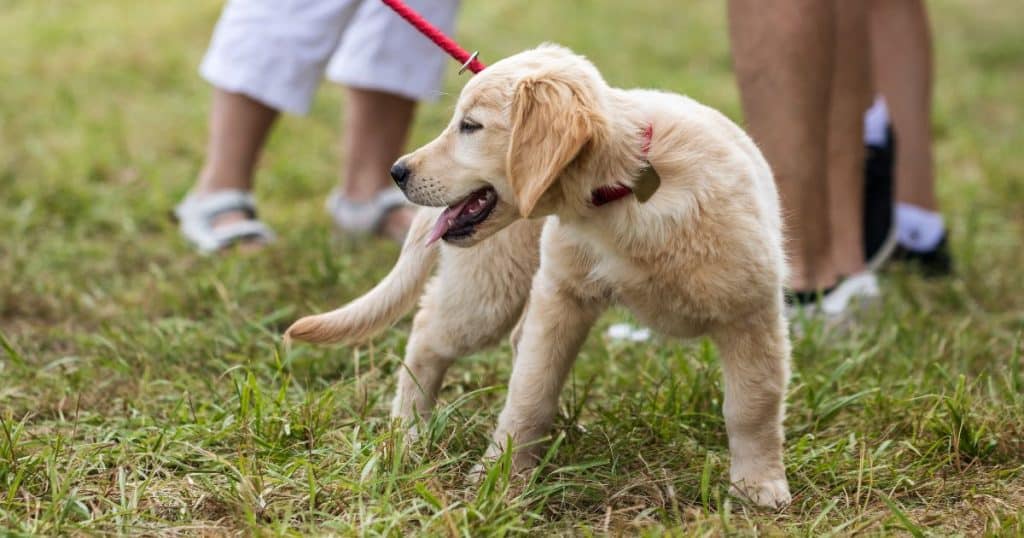
If you want your Golden Retriever puppy to grow into a well-behaved and obedient adult dog, it is essential to start with basic obedience training. Basic obedience training is the foundation for all other obedience skills and commands your puppy will learn in the future.
Leash Training
Leash training is an essential part of basic obedience training. It teaches your puppy to walk calmly on a leash without pulling or tugging. The first step is to get your puppy used to wearing a collar or harness. Once your puppy is comfortable wearing a collar, attach a leash and let your puppy drag it around the house. This will help your puppy get used to the weight and feel of the leash.
When you are ready to start leash training, take your puppy to a quiet area with few distractions. Hold the leash loosely and let your puppy explore. If your puppy pulls or tugs, stop walking and wait for your puppy to calm down. Reward your puppy with praise and treats when they walk calmly beside you.
Crate Training
Crate training is another essential part of basic obedience training. It teaches your puppy to see their crate as a safe and comfortable space. The first step is to choose the right size crate for your puppy. It should be big enough for your puppy to stand up, turn around, and lie down comfortably.
Introduce your puppy to the crate gradually. Start by placing treats and toys inside the crate and leaving the door open. Encourage your puppy to explore the crate and go inside. Once your puppy is comfortable going in and out of the crate, start closing the door for short periods while you are in the room. Gradually increase the time your puppy spends in the crate, and always reward them with praise and treats.
Remember, basic obedience training is an ongoing process that requires patience, consistency, and positive reinforcement. With time and practice, your Golden Retriever puppy will learn essential obedience skills like sit, stay, and come. These skills will help your puppy become a well-behaved and obedient adult dog.
Rewards and Positive Reinforcement
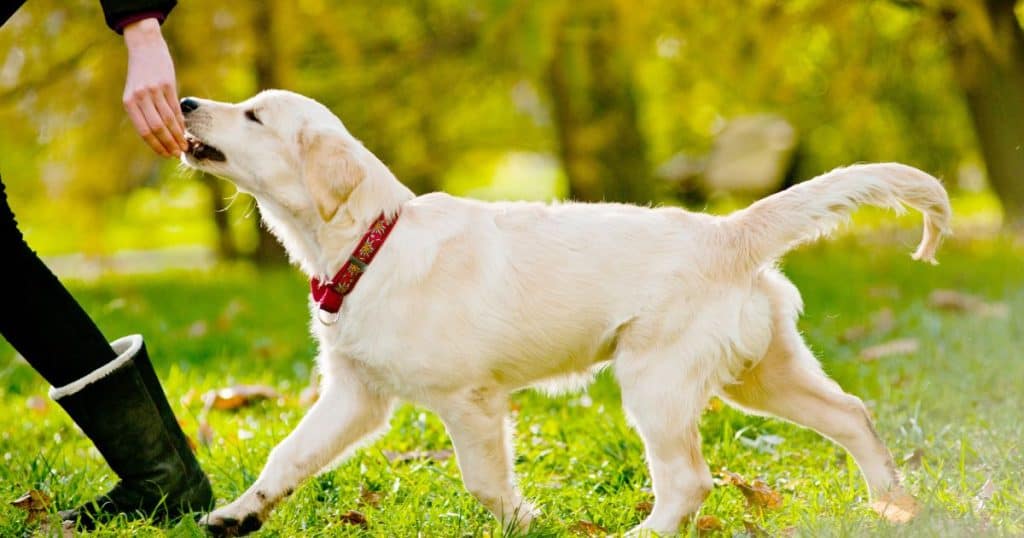
When it comes to training your Golden Retriever puppy, rewards and positive reinforcement are essential. Positive reinforcement training involves rewarding your dog for the things they do right, and it’s one of the most effective ways to train your puppy.
A reward can be anything that your dog finds rewarding, such as treats, praise, toys, or playtime. When you reward your dog for good behavior, they are more likely to repeat that behavior in the future. By using positive reinforcement, you can teach your puppy to associate good behavior with rewards, making training a fun and rewarding experience for both you and your puppy.
Training treats are an excellent way to reward your puppy during training sessions. Choose small, soft treats that your puppy can easily eat, and make sure to use them sparingly. You don’t want to overfeed your puppy or make them lose interest in the treats. Use treats to reward your puppy for good behavior, such as sitting, staying, or coming when called.
Praise is another powerful tool for positive reinforcement training. Dogs love to be praised and will respond well to positive feedback. When your puppy does something right, make sure to praise them immediately. Use a happy, upbeat tone of voice and give them lots of attention and affection.
Remember that rewarding good behavior is more effective than punishing bad behavior. Punishing your puppy can lead to fear and anxiety, making training more difficult. Instead, focus on rewarding your puppy for good behavior, and they will quickly learn what you expect from them.
In summary, rewards and positive reinforcement are essential for training your Golden Retriever puppy. Use treats, praise, and other rewards to encourage good behavior, and your puppy will quickly learn what you expect from them. With patience, consistency, and positive reinforcement, you can train your puppy to be a well-behaved, happy companion.
Socialization and Dealing with Fear Stages
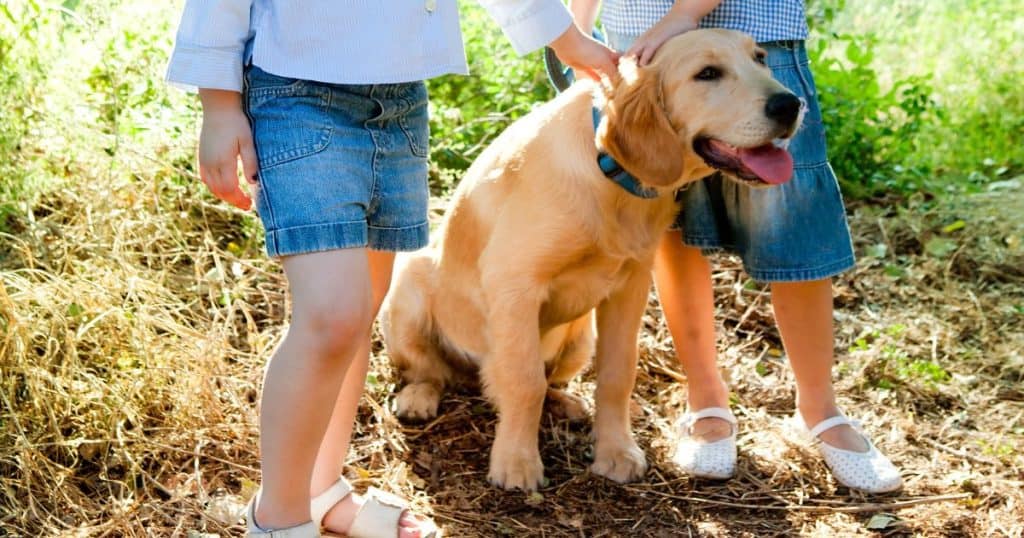
One of the most important aspects of training a Golden Retriever puppy is socialization. Socialization is the process of introducing your puppy to different people, places, sights, and sounds. It is essential for your puppy to develop a positive attitude towards the world around them.
Socialization begins with the breeder and continues with you. It is important to expose your puppy to different experiences in a safe and controlled environment. Well-run puppy classes are a good way to socialize your puppy and provide them with opportunities to interact with other dogs and people.
During the socialization process, you may encounter your puppy’s fear stages. Fear stages are periods when your puppy may become more fearful and anxious. The first fear stage usually occurs around 8-11 weeks of age. It is important to continue socializing your puppy during these stages, but also be aware of their fears and avoid overwhelming them with too much at once.
If your puppy shows signs of fear during socialization, it is important to respond appropriately. For example, if your puppy does not eat or play during a socialization session, they are telling you they are frightened. Take your puppy out of the situation and plan for a quieter session.
Dealing with fear stages can be challenging, but it is important to remain patient and supportive. It is important to continue socializing your puppy during these stages, but also be aware of their fears and avoid overwhelming them with too much at once.
In summary, socialization is an essential aspect of training a Golden Retriever puppy. It is important to expose your puppy to different experiences in a safe and controlled environment. During the socialization process, you may encounter your puppy’s fear stages. It is important to respond appropriately and continue socializing your puppy during these stages.
House and Potty Training
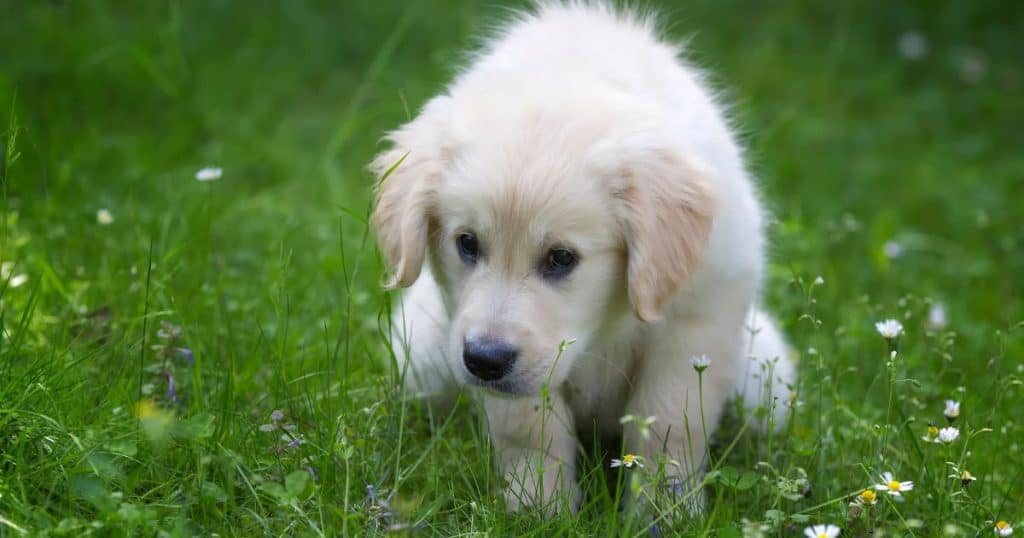
If you’re thinking about getting a Golden Retriever puppy, you should know that house and potty training are essential parts of their early development. Fortunately, with the right approach and consistency, you can train your puppy to use the bathroom outside and keep your home clean.
One of the most effective methods for house and potty training is crate training. By using a crate, you can create a safe and comfortable space for your puppy to rest and relax, while also teaching them to hold their bladder and bowels. It’s important to choose the right size crate for your puppy, as they should have enough room to stand up, turn around, and lie down comfortably.
When it comes to potty training, consistency is key. Take your puppy outside frequently, especially after meals, naps, and playtime. Use a specific command, such as “go potty,” to help your puppy associate the behavior with the command. Reward your puppy with praise and treats when they successfully go outside, but don’t punish them for accidents inside. It’s important to remember that accidents will happen, especially in the early stages of training.
In addition to crate training and potty training, it’s important to establish a routine for your puppy. This includes feeding, exercise, and playtime, as well as bathroom breaks. By establishing a routine, you can help your puppy develop good habits and reduce the likelihood of accidents inside.
Overall, house and potty training are essential parts of raising a Golden Retriever puppy. With the right approach and consistency, you can train your puppy to use the bathroom outside and keep your home clean. Remember to be patient and consistent, and don’t hesitate to seek professional help if you’re struggling with training your puppy.
Dealing with Common Puppy Behaviors
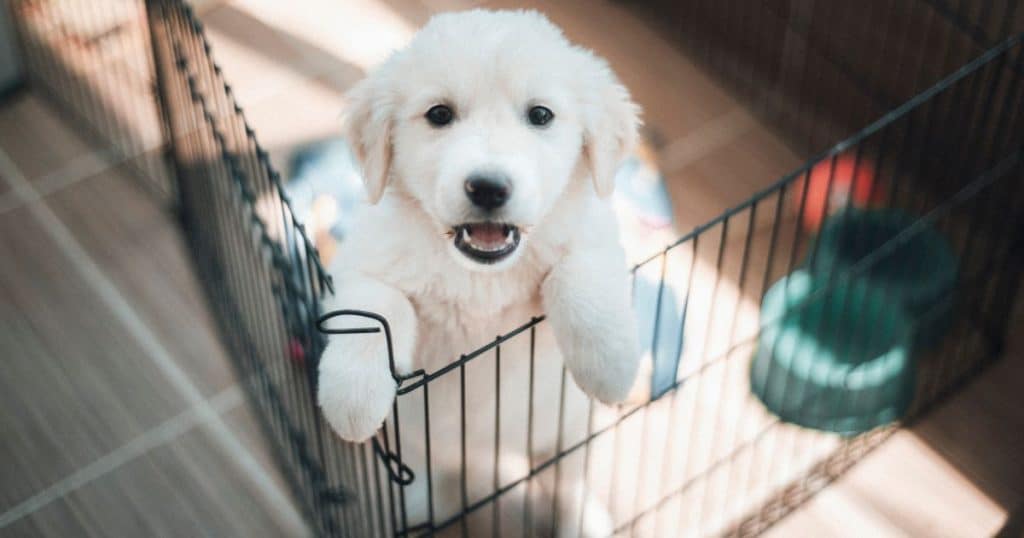
Training a Golden Retriever puppy can be challenging, especially when dealing with common puppy behaviors such as chewing, teething, and short attention spans.
One of the most common behaviors that Golden Retriever puppies exhibit is chewing. Puppies will chew on anything they can get their teeth on, including shoes, furniture, and even walls. To prevent this behavior, provide your puppy with plenty of chew toys and redirect their attention to the toys whenever they start to chew on something they shouldn’t.
Teething is another common behavior that puppies exhibit. During this time, puppies will chew on anything they can find to help alleviate the discomfort of their growing teeth. To help your puppy through this phase, provide them with plenty of chew toys and frozen treats to help soothe their gums.
Distractions can also be a problem when training a Golden Retriever puppy. Puppies have short attention spans and can easily become distracted by their surroundings. To combat this, train your puppy in a quiet, distraction-free environment and gradually increase the level of distractions as they become more focused.
It’s important to recognize the signs of common behaviors such as chewing, teething, and short attention spans. By doing so, you can prevent these behaviors from becoming habits that are difficult to break.
In summary, dealing with common puppy behaviors when training a Golden Retriever puppy can be challenging, but with patience and persistence, you can help your puppy develop good habits and become a well-behaved companion.
Advanced Training Skills and Techniques
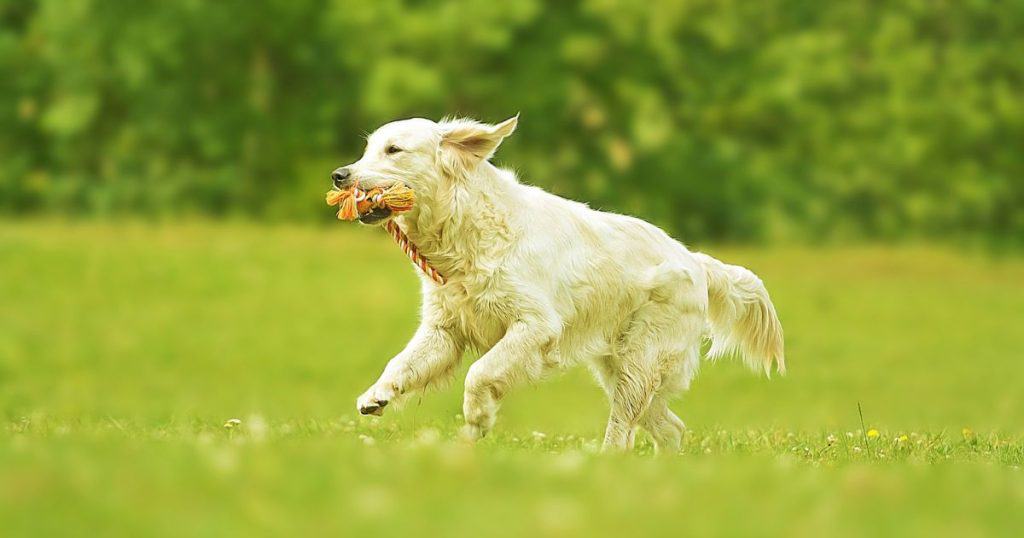
Once your Golden Retriever puppy has mastered basic training skills, it’s time to move on to more advanced techniques. These skills will not only impress your friends and family but also help keep your furry friend mentally stimulated and happy.
One of the most impressive skills a Golden Retriever can learn is retrieving. Retrieving is a natural instinct for this breed, but with proper training, you can teach your pup to retrieve specific objects on command. Start by teaching your dog to fetch a ball or toy, and gradually increase the difficulty by introducing new objects and obstacles.
Another important skill to teach your Golden Retriever is to stay. This command can be extremely useful in situations where you need your dog to remain in one spot for an extended period. Start by teaching your dog to sit and then add the stay command. Gradually increase the length of time your dog must stay in place before being rewarded.
When it comes to training methods, positive reinforcement is key. Reward your dog for good behavior with treats, praise, and playtime. Punishing your dog for bad behavior will only confuse and upset them, so always focus on positive reinforcement.
The training process for advanced skills can take time, so be patient and consistent. Break down each skill into small steps and focus on one step at a time. Practice regularly, and gradually increase the difficulty as your dog becomes more comfortable with each step.
In conclusion, advanced training skills and techniques are essential for keeping your Golden Retriever mentally stimulated and happy. Retrieving and staying are just two of the many skills you can teach your dog through positive reinforcement and consistent training. With patience and practice, you and your furry friend can achieve impressive results.
When to Seek Professional Help
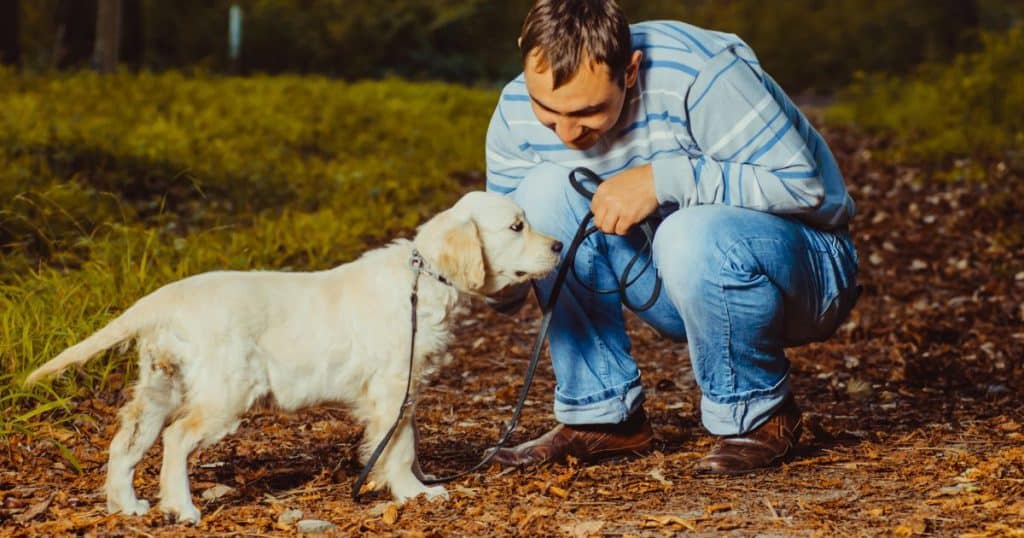
If you encounter challenges or behavioral issues while training your Golden Retriever puppy, it’s essential to seek guidance from a qualified dog trainer or behaviorist. Professional dog trainers have the knowledge and experience to handle any training issues that may arise during the training process.
Puppy Kindergarten and basic obedience classes are an excellent way to start training your Golden Retriever puppy. However, if you notice that your puppy is not responding to the training or is showing signs of aggression, it may be time to seek professional help.
Professional dog trainers can help you understand your puppy’s behavior and provide you with the tools and techniques to train your puppy effectively. They can also help you address any behavioral issues that may be hindering your puppy’s progress.
It’s important to find a qualified dog trainer or behaviorist who has experience training Golden Retrievers. They should be able to provide you with a customized training plan that fits your puppy’s unique needs.
Remember, training your Golden Retriever puppy takes time, patience, and consistency. Don’t be afraid to seek professional help if you need it. With the right guidance and training, your Golden Retriever puppy can become a well-behaved and obedient companion.
Maintaining Training as Your Puppy Grows
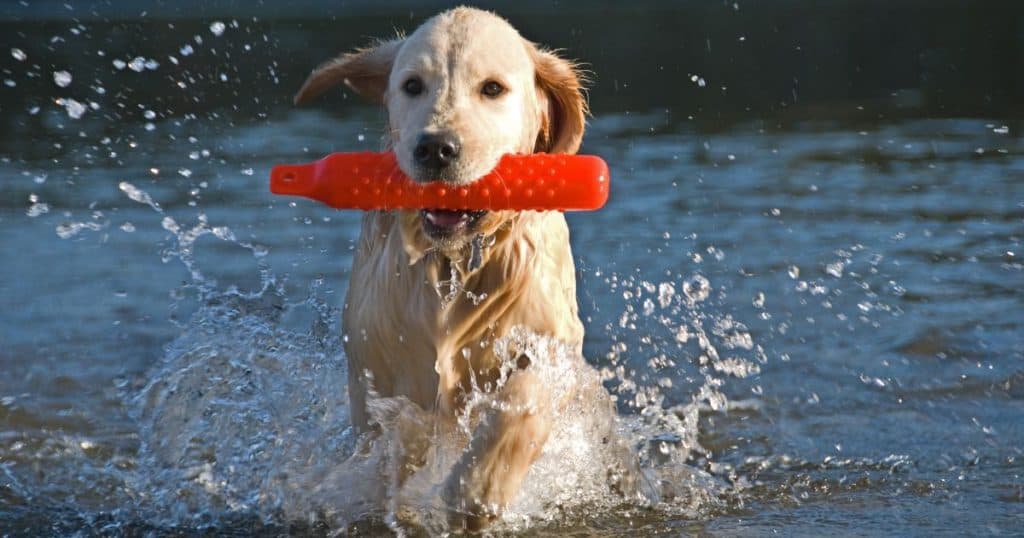
As your Golden Retriever puppy grows, their training needs will change. It is important to continue training them to ensure they develop good manners and mental stimulation.
When your puppy reaches around six months old, they will begin to enter adolescence. During this period, they may become more independent and less eager to please. It is important to continue training them during this time to ensure they do not develop bad habits.
As your Golden Retriever puppy becomes an adult dog, their training needs will change again. They will be fully grown and may require more mental stimulation to keep them engaged. It is important to continue training them to ensure they maintain good manners and remain mentally stimulated.
To maintain their training, it is important to continue practicing basic obedience commands such as sit, stay, and come. You can also introduce new commands and tricks to keep them mentally stimulated.
Regular exercise is also important for maintaining good behavior. Golden Retrievers are an active breed and require plenty of exercise to keep them happy and healthy.
In summary, it is important to continue training your Golden Retriever puppy as they grow to ensure they maintains good manners and mental stimulation. Regular exercise and practicing basic obedience commands are key to maintaining their training.
FAQs
How long does it take to train a Golden Retriever puppy?
The duration of training a Golden Retriever puppy depends on various factors such as consistency, patience, and the dog’s personality. Generally, it takes around six months to a year to train a Golden Retriever puppy. However, some puppies may take longer, and others may take a shorter time.
What are the best techniques for training a Golden Retriever puppy?
There are various techniques for training a Golden Retriever puppy. The most effective method is positive reinforcement training. This technique involves rewarding your puppy for good behavior and ignoring bad behavior. Another technique is clicker training, which involves using a clicker to mark the desired behavior and then rewarding the puppy.
What are the most important commands to teach a Golden Retriever puppy?
The most important commands to teach a Golden Retriever puppy are sit, stay, come, and down. These commands are essential for controlling your puppy and keeping them safe. Other important commands include heel, leave it, and drop it.
How do you potty train a Golden Retriever puppy?
Potty training a Golden Retriever puppy requires consistency, patience, and positive reinforcement. You should take your puppy outside frequently and reward them when they go potty outside. You should also establish a routine and supervise your puppy when they are inside to prevent accidents.
What are some common mistakes to avoid when training a Golden Retriever puppy?
Common mistakes to avoid when training a Golden Retriever puppy include using punishment-based training, inconsistency, and not socializing your puppy. Punishment-based training can cause fear and anxiety in your puppy and lead to aggressive behavior. Inconsistency can confuse your puppy and slow down the training process. Socializing your puppy is crucial for their development and prevents behavior problems in the future.
How can you make training a Golden Retriever puppy fun and engaging?
You can make training a Golden Retriever puppy fun and engaging by using positive reinforcement, incorporating games, and keeping training sessions short and frequent. Positive reinforcement involves rewarding your puppy for good behavior and can make training enjoyable for your puppy. Incorporating games such as fetch and hide-and-seek can make training sessions more interactive and exciting for your puppy. Keeping training sessions short and frequent can prevent your puppy from getting bored and losing interest.
Remember, training a Golden Retriever puppy requires patience, consistency, and positive reinforcement. With the right techniques and approach, you can train your puppy to be a well-behaved and obedient companion.

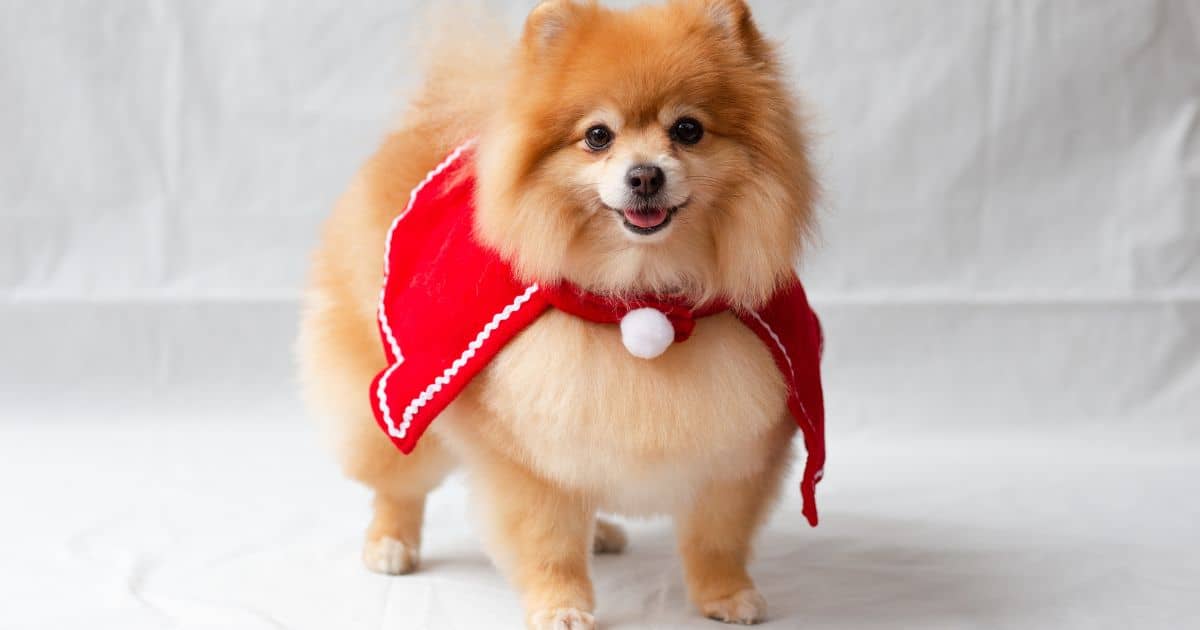
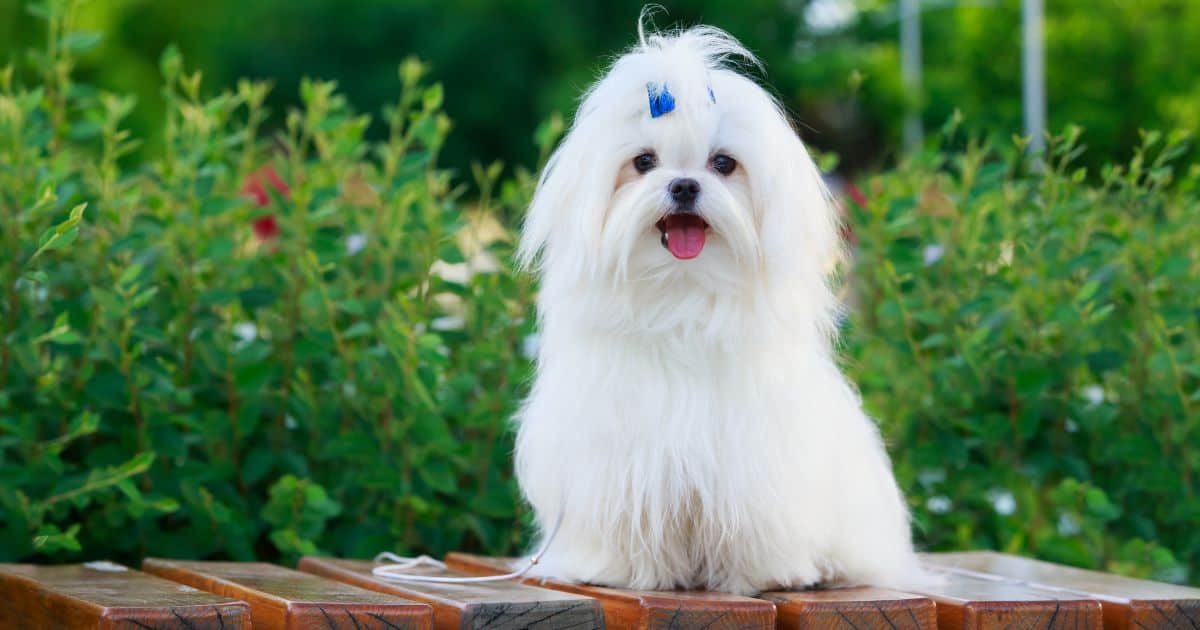
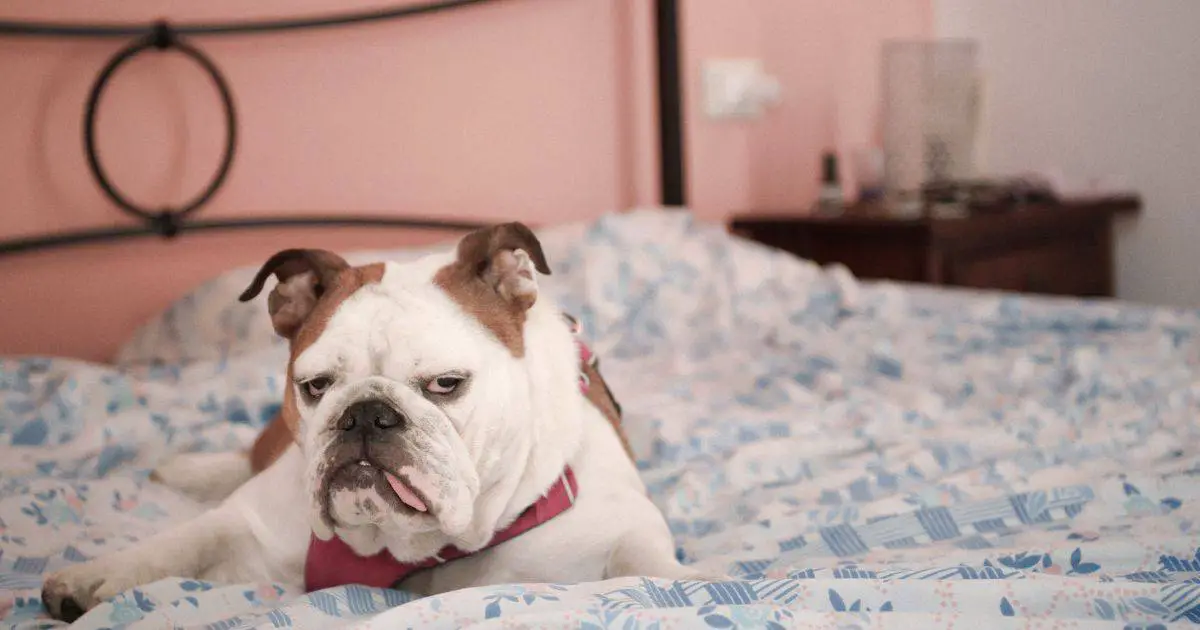
Leave a Reply
You must be logged in to post a comment.